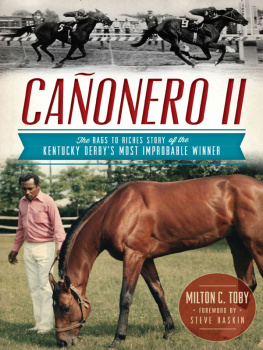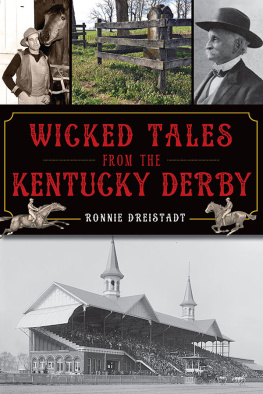DANCERS
IMAGE

T HE F ORGOTTEN S TORY OF
THE 1968 K ENTUCKY D ERBY
M ILTON C . T OBY

Published by The History Press
Charleston, SC 29403
www.historypress.net
Copyright 2011 by Milton C. Toby
All rights reserved
Front cover images: George Featherston photos, courtesy of the Thoroughbred Times.
First published 2011
e-book edition 2011
ISBN 978.1.61423.181.3
Library of Congress Cataloging-in-Publication Data
Toby, Milton C.
Dancers image : the forgotten story of the 1968 Kentucky Derby / Milton C. Toby.
p. cm.
Includes bibliographical references.
print edition ISBN 978-1-60949-095-9
1. Native Dancer (Race horse) 2. Race horses--United States--Biography. 3. Kentucky
Derby--History. 4. Horse racing--Kentucky. I. Title.
SF355.N38T63 2011
636.12092--dc22
[B]
2011004504
Notice: The information in this book is true and complete to the best of our knowledge. It is offered without guarantee on the part of the author or The History Press. The author and The History Press disclaim all liability in connection with the use of this book.
All rights reserved. No part of this book may be reproduced or transmitted in any form whatsoever without prior written permission from the publisher except in the case of brief quotations embodied in critical articles and reviews.
C ONTENTS
A CKNOWLEDGEMENTS
This book would not have been possible without the help of a great number of people: Peter Fuller granted access to the extensive legal files relating to the case; Attorney Edward S. Bonnie was generous with his time and resources; Phyllis Rogers, associate librarian at the Keeneland Library, helped me locate information in what is almost certainly the largest collection of Daily Racing Forms and Morning Telegraphs in existence anywhere; Christopher Goodlett, curator of the research library at the Kentucky Derby Museum in Louisville, Kentucky, tracked down notes and interviews from the collection of the late Jim Bolus, who championed the cause of Dancers Image through the years; former reporter Billy Reed shared his recollections of the 1968 Derby; Neil Chethik, writer in residence at the Carnegie Center in Lexington, Kentucky, has mentored me through a variety of writing projects; Sally Jump, clerk of the Franklin Circuit Court; Denise Shanks, reference librarian at the Lexington Public Library; the staff at the Kentucky Department for Libraries and Archives; Stacy Bearse, former publisher of the Blood-Horse; Anne Keogh, chief photographer at the Blood-Horse; Mark Simon, editor of the Thoroughbred Times; everyone at The History Press; and last but not least, my wife, Roberta. Her support has been immeasurable.
I NTRODUCTION
At the head of the stretch, riding one of the favorites in the most important horse race in the world, jockey Bobby Ussery dropped his whip.
It was an accidentone of those unfortunate things that just happen sometimesbut it could not have come at a worse point in the race for Ussery. The veteran jockey had hustled Dancers Image up from dead last in the field of fourteen, weaving through horses on the final turn like the legendary Crazy Legs Hirsch. When a hole opened up on the rail, Ussery cut to the inside toward clear running room. That was when the stick fell from his grasp. One second Ussery had the whip clutched in his right hand, waving it at the horses flank; the next second it was gone. Dancers Image was in gear, moving fast on the leaders, but the strapping gray colt still had the pacesetter and the favorite to catch.
And, suddenly, his jockey had no whip.
It happened so quickly that hardly anyone in the stands noticed. Even when watching a replay of the race, Usserys gaffe is not obvious unless you know just when to pay attention.
I didnt even know I lost it, Ussery told reporters after the race. They tell me I dropped it at the three-sixteenths pole.
In other circumstances, it might have sounded like an idle boast from a rider trying to cover up what could have been a fatal mistake in a major race. But it was not that at all; Ussery was simply stating a fact. He did not need the stick because Dancers Image was good enough to win on his own.
The official Daily Racing Form chart for the 1968 Kentucky Derby refers to Usserys vigorous hand ride in the stretch after the rider lost his whip, but those words pale in comparison to what actually happened through the final quarter mile. Crouched low over the horses neck, his sights set on the leaders, Ussery was riding hard, pushing Dancers Image with his legs, his hands and his voice. He kept the colt tight on the rail, and Dancers Image surged to the front in the final furlong. He drew clear and won by 1 lengths. The chart caller for the Form said that Dancers Image was hard pressed to beat the favorite, Calumet Farms Forward Pass, but that assessment belies a dramatic stretch run dominated by the winner. There was little doubt that the big, gray colt was the best horse that day.
Usserys masterful ride in the ninety-fourth Kentucky Derby marked an important milestone for the Oklahoma native, who became the first winner of back-to-back Kentucky Derbys in more than sixty years. Eddie Arcaro won the race five times, but he could not win two in a row and neither could four-time winner Bill Hartack. Usserys victory the previous year on long shot Proud Clarion had been an unlikely one; a year later, Ussery was confident the long stretch run at Churchill Downs favored Dancers Image and the colts heart-stopping, come-from-behind running style. Before the race, Ussery predicted that Dancers Image would be there at the wire.
He could not have been more right.
The win was a dream come true for Boston automobile dealer Peter Fuller, who bred and owned Dancers Image, and for veteran Canadian trainer Lou Cavalaris Jr., who nursed the colts sore ankles through a demanding three-year-old campaign and got him to the Derby sound enough to win. Dancers Image was the first Kentucky Derby starter for both men, and the broad smiles on their faces, as they led the colt into the Churchill Downs winners circle, showed how much they were savoring the moment. Curiously, though, in some of the photographs, Cavalaris is staring down, apparently assessing the Derby winners fragile front ankles.
The $5,000 gold trophy awarded to the winning owner each year was the holy grail of Thoroughbred racing, and it belonged to Fullerfor a while, at least. As events unfolded, keeping the coveted Derby trophy would prove far more difficult than winning it.
Later that evening, more than one hundred people showed up for the traditional winners celebration hosted by Churchill Downs president Wathen Knebelkamp. Fuller was the life of the partyand for good reason. Only one three-year-old is good enough to win the Kentucky Derby each year, and in 1968, that horse was Dancers Image.
While the party was in full swing in the tracks private dining room, there was activity of another kind going on in the barn area. A lab technician toiling in a cramped trailer was mixing chemicals with urine samples collected from the winners of each race on Derby Day. One of the numbered samplesthe technician at the time did not know from which horseunexpectedly changed color when the reagent was added. It was a preliminary screening test, not specific for any particular prohibited medication, but the color change indicated that something was wrong.












